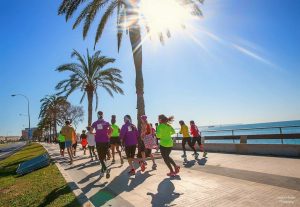There are so many changes to your body when you’re going through the menopause transition. One which is not commonly talked about is noticing a difference in your skin. Anecdotally, many women tell me that alongside noticing some skin sagging and wrinkles, their skin seems to become more delicate and sensitive. This can be a real problem for runners whose skin is regularly exposed to the elements, to friction, to sweat and to frequent washing.
I’ve decided to do a little mini-series looking at the skin changes in perimenopause that can affect us as runners. So far we’ve had:
- Part 1 – skin chafing
- Part 2 – vaginal atrophy
- Part 3 – skin sensitivity
This is Part 4, the final in the series and the topic is sun damage.
One of the great things about being a runner is getting to spend so much time outside. Inhaling the fresh air, seeing the seasons change and being in nature are some of the reasons I absolutely love to run. Hours on the road however do mean that our skin is exposed to all the elements including a good dose of sunshine. And while we need some direct sunlight on our skin to make vitamin D, a large amount of ultraviolet (UV) light exposure can damage skin.
Here are 4 signs of sun damage to your skin:
1. Sunburn.
The obvious one first. Burnt skin feels hot and looks red. Your skin is trying to limit and repair the damage so it dilates up the tiny blood vessels in the skin to bring more blood to the area, that’s why the skin is red. Dead skin cells dry out and flake off. Intermittently burning is worse for your skin than a gradual tanning.
2. Actinic keratoses (or solar keratoses).
These are skin lesions which are more common over fifty as they result from years of sun exposure. Dry, rough or scaly patches form on sun exposed areas such as your face or forearms. They can be pink, brownish or even a deeper red and they usually have a white crust or scale on the top. There’s a small risk that an actinic keratosis can turn into a squamous cell carcinoma (a type of skin cancer) so they are usually removed but in themselves they aren’t harmful and will often go away on their own. You can read more (and see a photo) of actinic keratoses on the NHS website.
3. Basal cell carcinoma.
This is an important skin cancer lesion for older runners to be aware of as they are linked to sun exposure. More men get these than women and they are usually on the head and neck. They tend to start as a very small pink or pearly coloured lump which gradually grows over many months but they can begin as irritated patches of skin. They can bleed, crust or sometimes ulcerate. It’s rare for this type of skin cancer to metastasise but they do need to be removed.
4. Malignant melanoma.
Melanoma is the fifth most common cancer in the UK and its incidence has increased by over 50 per cent in the last ten years. While melanoma can affect younger people, it does become more common with age and one third of people with melanoma are over 75 years old. Melanocytes are cells which produce the pigment called melanin which protects our skin from UV radiation. Around 85 per cent of melanomas are caused by excessive UV radiation. In women, melanomas are most commonly on the legs.
The risk of developing melanoma is higher if you have:
- Pale skin that burns
- Red or blonde hair
- Blue or green eyes
- Lots of freckles or moles
- Had lots of sun exposure, particularly when you have burnt
- Used sun beds
- A family history of melanoma (Around 10 per cent of melanomas are genetic and not linked to sun exposure)
How do you spot melanoma?
We should all be aware of the risk of melanoma, particularly if we fall into any of the above categories. The most important thing we can do is to keep an eye on our skin and get to know all our moles. We need to know if new abnormal moles are appearing or if any of the ones we already have are changing. Taking photographs can be a good way to do this. Mole mapping and surveillance are available privately if you have large numbers of moles or are concerned.
Here are the changes to a mole that indicate it might be suspicious:
- An increase in the size of a mole (most melanomas are bigger than 6mm)
- An increase in thickness of a mole
- A mole is changing shape or spreading outwards
- A mole bleeds or crusts
- A mile becomes itchy or inflamed
- A change in the pigment, for example it’s developing darker speckles or blotches within it.
If you notice any of these changes in a mole, don’t panic. It doesn’t necessarily mean you have cancer but your mole does need to be checked by your doctor. The most likely thing that will happen is that you will be referred to a specialised clinic for assessment and removal of the mole.
How to protect your skin from sun damage
As a runner, it’s vital that we take steps to protect our skin from sun damage. Being outside is so good for us but we need to take action against the risks. This isn’t rocket science but simple things done regularly are always the best bet.
- Wear a good sunscreen with at least SPF 15, whenever you run, even on cloudy days but especially on sunny days. Find one that doesn’t slide off and sting your eyes when you sweat.
- Wear a cap or visor that will shade your face. Consider a cap with a flap at the back which covers your neck.
- Cover your shoulder and arms on long runs.
- Avoid running in the worst heat of the day in summer months – between 11am and 3pm.
- Wear good quality sunglasses, it’s possible to get melanomas in your eye.
Sometimes it’s just a case of being well prepared. This is particularly true if you’re running or racing abroad. I was not expecting it to be so hot the year I ran the Boston marathon and had to buy a hat at the expo. Don’t be like me and turn up to a marathon without sunscreen and have to ask other runners you don’t know if you can borrow theirs! This was in London and the weather was very different to North West England! Be organised, think ahead and prepare for sun protection.
Our skin is amazing, it does so much to protect us but our risks of sun damage do increase as we get older so the menopause is a great opportunity to make sure we are looking after it as well as we can. Always see your doctor if you have any skin changes that are persistent and you don’t know what they are.
If you’ve enjoyed this post, you’ll love my weekly tips and motivation for menopausal runners. Join hundreds of other women by signing up to get my newsletter below. Or why not sign up for my Run Through the Menopause course? You can start today!






